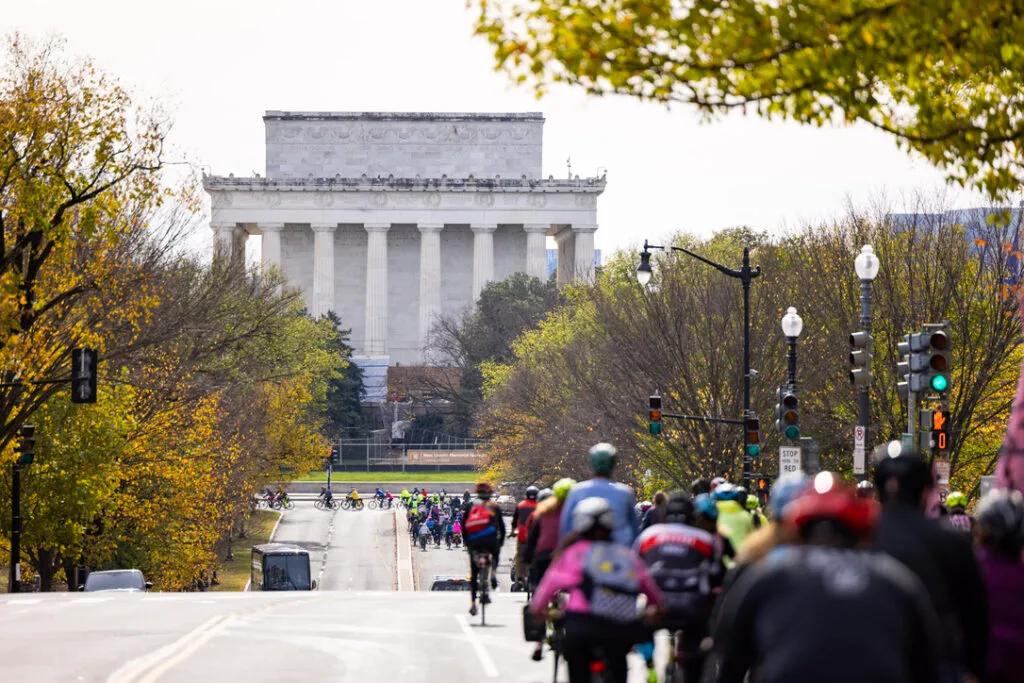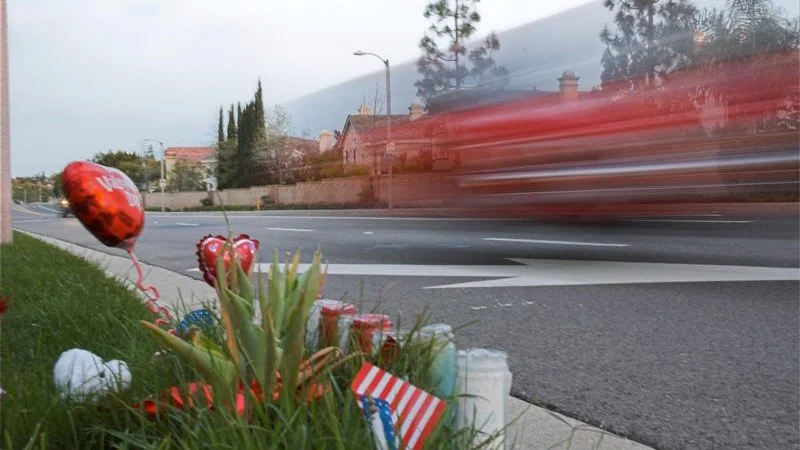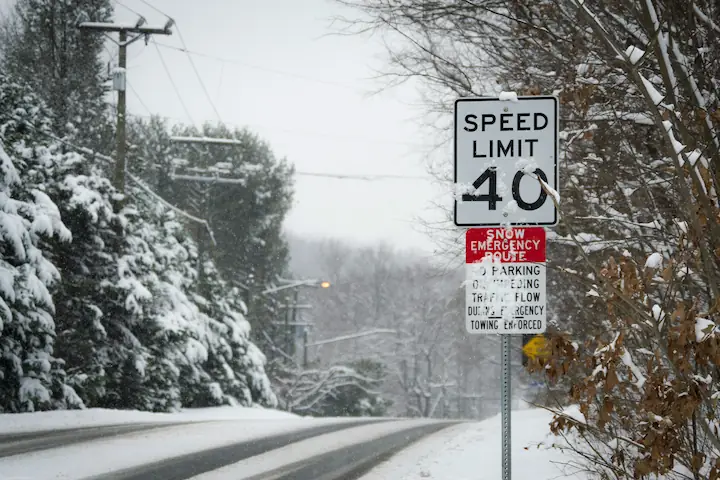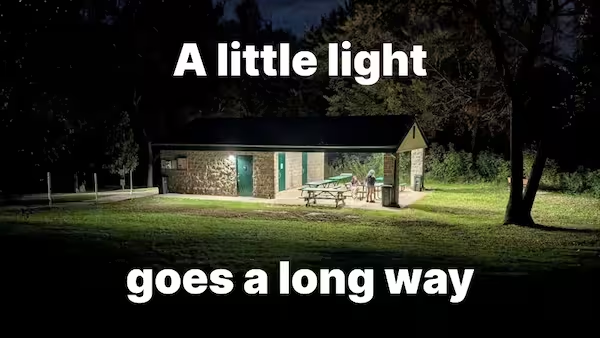Editor's Note: The challenges our cities face are growing, but so is the strength of this movement. Every story we share, every idea we spread, and every tool we build exists because people like you are committed to showing up. Your membership isn’t passive—it’s the momentum that makes change possible.
On Sunday, November 16, I spoke at the Ride For Your Life rally at the Lincoln Memorial. It’s the largest event in the nation that honors people who have been killed in traffic crashes.
The American transportation death rate isn’t the result of personal failures. It’s a problem of professional and institutional indifference.
We’ve been saying this for a long time at Strong Towns. And something important is happening: members of our movement are working to reverse the trend; to show that our streets–not the people who rely on them–need to change, and to provide example after example of how to make that change.
If you want to learn more about the communities that are fighting back against unsafe streets using the Crash Analysis Studio model, or if you are interested in trying it out in your city, go here. But first, here’s the full transcript of my speech in Washington D.C.

It's really wonderful to be here with all of you at the Lincoln Memorial, a place where I've come, and many Americans have come, to remember what it means to value human life and dignity.
Back in December of 2014, I was in the city of Springfield, Massachusetts. A group had invited me out to look at a dangerous street, State Street, through the middle of the city. The city had recently rebuilt it and they had a lot of concerns. We went and looked at it. It was obviously very dangerous. There were people crossing from the library to the parking lot mid-block because it was the most logical place to cross. We sat there and watched people dodging cars, people almost getting hit.
That night, a little girl, Destiny Gonzalez, was killed crossing from the library to the parking lot with her mom and her niece. They had gone to story hour and they were heading home for the evening.
Right away, the next day, the blame started. The woman who hit them was intoxicated; easy to write off right. Her mother had crossed mid-block; she's, of course, somewhat to blame. What all of this blame did is it kept us from asking really difficult questions, or really important questions, about why that street is not safe.
Two more people have been killed since in the same exact location and the street remains unchanged.
Engineers believe that car crashes are the result primarily, almost exclusively, of driver error. If you look at what we do when there's a crash, we go out and we try to assign blame. The data that we collect all goes to: who can we point fingers towards.
Was the driver speeding? Was the driver intoxicated? Was the driver distracted on their phone? These are easy questions that prevent us from asking the difficult questions that lead to change.
The pandemic actually presented us an opportunity to test this theory of engineers, that traffic crashes are caused by driver error. During the pandemic, as you all know and experienced, the amount that we drove went down. It went down dramatically. We all remember the eerie empty streets. If traffic crashes are caused by driver error, much much fewer drivers on the road should mean we had fewer crashes during the pandemic.
No. What did we have? Crashes went up. Deaths went up. Why did this happen?
What the pandemic revealed is how dangerous our streets actually are. When you remove the congestion, the artificial congestion that slows traffic down, what you see is that drivers drive the speeds that we have designed for. They drive at violent speeds. At high speeds. Our streets are over-engineered for speed. And so with a fraction of the drivers on the road, we had more crashes. We had more traumatic injuries. We had more deaths.
We all know that there is no enforcement campaign, there's no driver education campaign that can compensate for poorly engineered streets.
This is all worse when we get to biking and walking, right? When we get to biking and walking, the blame shifts even more. We've all heard the questions: Were they in a crosswalk? Were they riding in the bike lane? What were they wearing? This kind of blame prevents us from taking the next step. We need to clearly state that we need to take the next step.
It's not a problem of personal failure. This is a problem of professional and institutional indifference.
We have built a transportation system where the geometry, the lane widths, the sight distances, the turning radii, the signal timing, everything defaults to moving vehicles quickly, not keeping people safe. When the predictable happens, we blame those who are hurt.
If we want real change, we have to stop pretending that safety is the job of individuals and recognize that safety is the responsibility of everyone who designs and interacts with our systems.
Today, I want to introduce you to something very hopeful, something hopeful going on across America, because there is hope. There's a lot of progress. There's a lot of change going on, and it starts with asking a different set of questions.
At Strong Towns, we began the crash analysis studio a couple years ago. When a crash happens, what we do is we go out and we actually look at the site, and we ask a different set of questions. Not who do we blame, who can we point the finger at, but what were the many different factors that contributed to this crash? What are the many things, big and small, that when added up, made this crash inevitable?
When we do this, we involve what we call citizen professionals, people who know the area, and we involve technical professionals. The kind of engineers and planners and others who are part of designing and building the system. And here's where the magic that happens. When we ask this broader set of questions, what we find is that there's lots that we can do. There's an excitement in the room. Eyes open. Minds open. People say, geez, this wasn't an accident after all.
This is something that we're starting to see cities do. You talk about Vision Zero. We have some cities here in the U.S. – Jersey City, Hoboken – they've actually achieved it, year after year after year. The way they do it is not with mega projects. It's not with big, huge, expensive infrastructure. It's not with 10-year timelines and consultants and big studies. What do they do?
They do the little things, day after day. The small, little changes. They're immediate. They're human scale. These are the kind of changes that you have been asking for. They're the kind of changes that Sarah needed. It's the kind of changes that families across the country have been begging for.

.webp)
This is the kind of change that Sarah's act will make easier. The act doesn't create new mandates. It doesn't force states or cities to do anything. It doesn't tell anyone how to design their streets. All it does is remove excuses. It gives states the flexibility to do the things that we all know will make streets safer. That's why I'm supporting it, and that's why I hope you will support it as well.
But let's be clear. Legislation is not enough. The change that we need requires you. It requires your presence, your persistence. It requires your patience, your perseverance. It requires your stories, your empathy. Your refusal to accept that people dying on our streets is just the cost of doing business in America.
One of our earliest crash studios was in the city of Hyattsville, not too far from here. A young woman, an immigrant, was walking to cross the street. She had a blood alcohol level that was, let's say, pretty high. She was killed at a designated crosswalk late at night. And everything was kind of immediately written off as “intoxicated woman stumbles onto street.” It was easy to blame her.
We went and looked at this site. We gathered all the data, the speed data. We did analysis. We brought people in. We started to ask: what were the many factors that contributed to this crash. And what we found is a myriad of things. There's a neighborhood on one side of the street. and a major metro rail stop on the other. There's people crossing all the time. They built a fence down the middle of the road to keep the humans in line, to funnel them down to a designated crossing. That designated crossing is at the end of an acceleration lane. And at the time of day when this young woman was killed, the lights lighting up that intersection (to make sure that the drivers can all see each other) cast deep, deep shadows where a human would be standing and walking off.
I went to visit the site yesterday. I hadn't been there for a while. It's been two years. Nothing has changed.
.webp)
We cannot, we must not share and accept that level of indifference. Her family deserves better. Destiny Gonzalez deserves better. Sarah deserves better. You and your loved ones deserve better.
Let's give our support to Sarah's bill, but let's demonstrate that support by each of us showing up in our own communities. Because no bill, no law, no federal legislation will replace what you can do by joining with others in the place that you love.
Change begins with the people who refuse to look away. Let's be the people who refuse to look away.

[[divider]]
Responsible cities analyze traffic crashes to save lives. Yours can too.
Adopt the Crash Analysis Studio model and build a response focused on preventing future harm, not just assigning blame.





